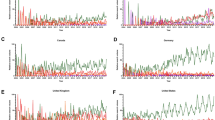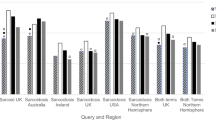Abstract
The primary aim of this study was to test the hypothesis that the symptom of tinnitus demonstrates a seasonal pattern with worsening in the winter relative to the summer using Internet search engine query data. Normalized search volume for the term ‘tinnitus’ from January 2004 through December 2013 was retrieved from Google Trends. Seasonal effects were evaluated using cosinor regression models. Primary countries of interest were the United States and Australia. Secondary exploratory analyses were also performed using data from Germany, the United Kingdom, Canada, Sweden, and Switzerland. Significant seasonal effects for ‘tinnitus’ search queries were found in the United States and Australia (p < 0.00001 for both countries), with peaks in the winter and troughs in the summer. Secondary analyses demonstrated similarly significant seasonal effects for Germany (p < 0.00001), Canada (p < 0.00001), and Sweden (p = 0.0008), again with increased search volume in the winter relative to the summer. Our findings indicate that there are significant seasonal trends for Internet search queries for tinnitus, with a zenith in winter months. Further research is indicated to determine the biological mechanisms underlying these findings, as they may provide insights into the pathophysiology of this common and debilitating medical symptom.


Similar content being viewed by others
References
Baguley D, McFerran D, Hall D (2013) Tinnitus. Lancet 382(9904):1600–1607. doi:10.1016/S0140-6736(13)60142-7
Langguth B, Kreuzer PM, Kleinjung T, De Ridder D (2013) Tinnitus: causes and clinical management. Lancet Neurol 12(9):920–930. doi:10.1016/S1474-4422(13)70160-1
Izuhara K, Wada K, Nakamura K, Tamai Y, Tsuji M, Ito Y, Nagata C (2013) Association between tinnitus and sleep disorders in the general Japanese population. Ann Otol Rhinol Laryngol 122(11):701–706
Friberg E, Jansson C, Mittendorfer-Rutz E, Rosenhall U, Alexanderson K (2012) Sickness absence due to otoaudiological diagnoses and risk of disability pension: a nationwide Swedish prospective cohort study. PLoS ONE 7(1):e29966. doi:10.1371/journal.pone.0029966
Sindhusake D, Golding M, Newall P, Rubin G, Jakobsen K, Mitchell P (2003) Risk factors for tinnitus in a population of older adults: the blue mountains hearing study. Ear Hear 24(6):501–507. doi:10.1097/01.AUD.0000100204.08771.3D
Gopinath B, McMahon CM, Rochtchina E, Karpa MJ, Mitchell P (2010) Risk factors and impacts of incident tinnitus in older adults. Ann Epidemiol 20(2):129–135. doi:10.1016/j.annepidem.2009.09.002
Nondahl DM, Cruickshanks KJ, Huang GH, Klein BE, Klein R, Nieto FJ, Tweed TS (2011) Tinnitus and its risk factors in the Beaver Dam offspring study. Int J Audiol 50(5):313–320. doi:10.3109/14992027.2010.551220
Derebery MJ, Berliner KI (1998) Allergy for the otologist. External canal to inner ear. Otolaryngol Clin North Am 31(1):157–173
Yang AC, Huang NE, Peng CK, Tsai SJ (2010) Do seasons have an influence on the incidence of depression? The use of an Internet search engine query data as a proxy of human affect. PLoS ONE 5(10):e13728. doi:10.1371/journal.pone.0013728
Stockmann C, Ampofo K, Hersh AL, Carleton ST, Korgenski K, Sheng X, Pavia AT, Byington CL (2013) Seasonality of acute otitis media and the role of respiratory viral activity in children. Pediatr Infect Dis J 32(4):314–319. doi:10.1097/INF.0b013e31827d104e
Atkinson M (1947) Tinnitus aurium; some considerations concerning its origin and treatment. Arch Otolaryngol 45(1):68–76
Hilger JA (1949) Autonomic dysfunction in the inner ear. Laryngoscope 59(1):1–11. doi:10.1288/00005537-194901000-00001
Bilecki MM, Bernarde GE, Mezzalira R, Maestri JE, Cardoso JM, Avila FG (2005) Seasonality in vestibular disorders. Int Tinnitus J 11(2):185–188
Inaba R, Kurokawa J, Mirbod SM (2009) Comparison of subjective symptoms and cold prevention measures in winter between traffic control workers and construction workers in Japan. Ind Health 47(3):283–291
Inaba R, Mirbod SM (2010) Subjective musculoskeletal symptoms in winter and summer among indoor working construction electricians. Ind Health 48(1):29–37
Jourdy DN, Donatelli LA, Victor JD, Selesnick SH (2010) Assessment of variation throughout the year in the incidence of idiopathic sudden sensorineural hearing loss. Otol Neurotol 31(1):53–57. doi:10.1097/MAO.0b013e3181c4c2d6
Eysenbach G, Kohler C (2003) What is the prevalence of health-related searches on the World Wide Web? Qualitative and quantitative analysis of search engine queries on the Internet. AMIA Annu Symp Proc, pp 225–229
Ginsberg J, Mohebbi MH, Patel RS, Brammer L, Smolinski MS, Brilliant L (2009) Detecting influenza epidemics using search engine query data. Nature 457(7232):1012–1014. doi:10.1038/nature07634
Ayers JW, Althouse BM, Allem JP, Rosenquist JN, Ford DE (2013) Seasonality in seeking mental health information on Google. Am J Prev Med 44(5):520–525. doi:10.1016/j.amepre.2013.01.012
Ayers JW, Ribisl K, Brownstein JS (2011) Using search query surveillance to monitor tax avoidance and smoking cessation following the United States’ 2009 “SCHIP” cigarette tax increase. PLoS ONE 6(3):e16777. doi:10.1371/journal.pone.0016777
Carr LJ, Dunsiger SI (2012) Search query data to monitor interest in behavior change: application for public health. PLoS ONE 7(10):e48158. doi:10.1371/journal.pone.0048158
Ingram DG, Plante DT (2013) Seasonal trends in restless legs symptomatology: evidence from Internet search query data. Sleep Med 14(12):1364–1368. doi:10.1016/j.sleep.2013.06.016
Ingram DG, Matthews CK, Plante DT (2014) Seasonal trends in sleep-disordered breathing: evidence from Internet search engine query data. Sleep Breath. doi:10.1007/s11325-014-0965-1
Braun T, Harréus U (2013) Medical nowcasting using Google Trends: application in otolaryngology. Eur Arch Otorhinolaryngol 270(7):2157–2160. doi:10.1007/s00405-013-2532-y
Barnett A, Baker P, Dobson AJ (2012) Analysing seasonal data. R Journal 4(1):5–10
Rossignol L, Pelat C, Lambert B, Flahault A, Chartier-Kastler E, Hanslik T (2013) A method to assess seasonality of urinary tract infections based on medication sales and Google Trends. PLoS ONE 8(10):e76020. doi:10.1371/journal.pone.0076020
Pica N, Bouvier NM (2014) Ambient temperature and respiratory virus infection. Pediatr Infect Dis J 33(3):311–313. doi:10.1097/INF.0000000000000235
Ahmad N, Seidman M (2004) Tinnitus in the older adult: epidemiology, pathophysiology and treatment options. Drugs Aging 21(5):297–305
Park JH, Park SJ, Kim YH, Park MH (2013) Sensorineural hearing loss: a complication of acute otitis media in adults. Eur Arch Otorhinolaryngol. doi:10.1007/s00405-013-2675-x
Brummett RE (1993) Ototoxic liability of erythromycin and analogues. Otolaryngol Clin North Am 26(5):811–819
Adriaenssens N, Coenen S, Versporten A, Muller A, Minalu G, Faes C, Vankerckhoven V, Aerts M, Hens N, Molenberghs G, Goossens H, Group EP (2011) European Surveillance of Antimicrobial Consumption (ESAC): outpatient macrolide, lincosamide and streptogramin (MLS) use in Europe (1997–2009). J Antimicrob Chemother 66 Suppl 6:vi37–vi45. doi:10.1093/jac/dkr456
Suda KJ, Hicks LA, Roberts RM, Hunkler RJ, Taylor TH (2014) Trends and seasonal variation in outpatient antibiotic prescription rates in the United States, 2006–2010. Antimicrob Agents Chemother. doi:10.1128/AAC.02239-13
Hadlow NC, Brown S, Wardrop R, Henley D (2014) The effects of season, daylight saving and time of sunrise on serum cortisol in a large population. Chronobiol Int 31(2):243–251. doi:10.3109/07420528.2013.844162
Kumagami H, Terakado M, Takahashi H (2013) Distribution of glucocorticoid receptors and 11β-hydroxysteroid dehydrogenase isoforms in the human inner ear. Otol Neurotol 34(1):151–157. doi:10.1097/MAO.0b013e31826a55ad
Tahera Y, Meltser I, Johansson P, Bian Z, Stierna P, Hansson AC, Canlon B (2006) NF-kappaB mediated glucocorticoid response in the inner ear after acoustic trauma. J Neurosci Res 83(6):1066–1076. doi:10.1002/jnr.20795
Job A, Raynal M, Kossowski M (2007) Susceptibility to tinnitus revealed at 2 kHz range by bilateral lower DPOAEs in normal hearing subjects with noise exposure. Audiol Neurootol 12(3):137–144. doi:10.1159/000099025
Knipper M, Van Dijk P, Nunes I, Rüttiger L, Zimmermann U (2013) Advances in the neurobiology of hearing disorders: recent developments regarding the basis of tinnitus and hyperacusis. Prog Neurobiol 111:17–33. doi:10.1016/j.pneurobio.2013.08.002
Simoens VL, Hébert S (2012) Cortisol suppression and hearing thresholds in tinnitus after low-dose dexamethasone challenge. BMC Ear Nose Throat Disord 12:4. doi:10.1186/1472-6815-12-4
Stanton SJ, Mullette-Gillman OA, Huettel SA (2011) Seasonal variation of salivary testosterone in men, normally cycling women, and women using hormonal contraceptives. Physiol Behav 104(5):804–808. doi:10.1016/j.physbeh.2011.07.009
Snihur AW, Hampson E (2012) Click-evoked otoacoustic emissions: response amplitude is associated with circulating testosterone levels in men. Behav Neurosci 126(2):325–331. doi:10.1037/a0027193
Vanneste S, Plazier M, der Loo E, de Heyning PV, Congedo M, De Ridder D (2010) The neural correlates of tinnitus-related distress. Neuroimage 52(2):470–480. doi:10.1016/j.neuroimage.2010.04.029
Golm D, Schmidt-Samoa C, Dechent P, Kröner-Herwig B (2013) Neural correlates of tinnitus related distress: an fMRI-study. Hear Res 295:87–99. doi:10.1016/j.heares.2012.03.003
Spindelegger C, Stein P, Wadsak W, Fink M, Mitterhauser M, Moser U, Savli M, Mien LK, Akimova E, Hahn A, Willeit M, Kletter K, Kasper S, Lanzenberger R (2012) Light-dependent alteration of serotonin-1A receptor binding in cortical and subcortical limbic regions in the human brain. World J Biol Psychiatry 13(6):413–422. doi:10.3109/15622975.2011.630405
Mazurek B, Stöver T, Haupt H, Klapp BF, Adli M, Gross J, Szczepek AJ (2010) The significance of stress: its role in the auditory system and the pathogenesis of tinnitus. HNO 58(2):162–172. doi:10.1007/s00106-009-2001-5
Schaefer SM, Jackson DC, Davidson RJ, Aguirre GK, Kimberg DY, Thompson-Schill SL (2002) Modulation of amygdalar activity by the conscious regulation of negative emotion. J Cogn Neurosci 14(6):913–921. doi:10.1162/089892902760191135
Urry HL, van Reekum CM, Johnstone T, Kalin NH, Thurow ME, Schaefer HS, Jackson CA, Frye CJ, Greischar LL, Alexander AL, Davidson RJ (2006) Amygdala and ventromedial prefrontal cortex are inversely coupled during regulation of negative affect and predict the diurnal pattern of cortisol secretion among older adults. J Neurosci 26(16):4415–4425. doi:10.1523/JNEUROSCI.3215-05.2006
comScore Releases January 2013 U.S. Search Engine Rankings (2013) Accessed 26 April 2013
Acknowledgments
We greatly appreciate the efforts of Logan Zweifel, who assisted with collection of data used in these analyses. We also acknowledge Kenneth Lewoczko, M.D., who provided valuable feedback on the manuscript during preparation.
Conflict of interest
Dr. Plante is supported by unrelated research grants from the American Sleep Medicine Foundation, Brain and Behavior Research Foundation, and the National Institute of Mental Health (K23MH099234). He has also received royalties from Cambridge University Press. Dr. Ingram reports no conflicts of interest.
Author information
Authors and Affiliations
Corresponding author
Rights and permissions
About this article
Cite this article
Plante, D.T., Ingram, D.G. Seasonal trends in tinnitus symptomatology: evidence from Internet search engine query data. Eur Arch Otorhinolaryngol 272, 2807–2813 (2015). https://doi.org/10.1007/s00405-014-3287-9
Received:
Accepted:
Published:
Issue Date:
DOI: https://doi.org/10.1007/s00405-014-3287-9




